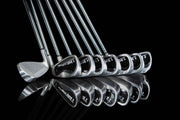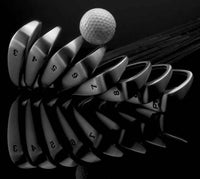The Truth About Golf Club Loft Angles
by David Lake
Remember when you asked your playing partner what iron he hit on a par #3?
Those days are long gone.
There is no standardization in the golf industry today as to loft angles which means that one brand’s #7 iron might be the equivalent to another brand’s #6 iron. Most golf club brands these days make their irons with one club stronger loft angles in order to give the illusion that their golf clubs produce increased distance. You have heard golfers say it a thousand times: “I can hit this #7 iron one club farther than my old #7 iron." The fact is that they can’t. What they can do is hit a #7 iron with a 31º loft angle farther than a #7 iron with a 35º loft angle. This practice is strictly a marketing ploy to mislead the customer and is a game that we refuse to play. When we speak of distance increases using 1 Iron Golf clubs we are referring to the increases you will get as a result of consistent solid ball contact coupled with the dynamics of club-head design and shaft optimization. In practically every case our customers will hit our 35º loft angle iron farther than their old 35º loft angle iron for exactly these reasons. You cannot compare one manufacturer’s numbered iron with that of another manufacturer, you have to compare loft angles. It just comes down to a comparison of apples to apples.
Up until around 2010 there was something of a gentleman’s agreement throughout the golf industry as to loft angle standards. Between brands there was little, if any, differentiation between the loft angles for the same numbered irons. As well, there was an exact loft angle progression between irons throughout the set that produced exact yardage gaps between irons within that set, typically being a 4.0º loft angle progression. This all changed when one brand decided, as a marketing ploy, to strengthen the loft angles of their mid-irons and advertise that their irons produced greater distances due to advanced technology. All of the other brands condemned them for this blatant act, but within a year or two all of them had followed suit – simply because this marketing ruse worked (alas, the unsuspecting consumer).
Other than being just a misleading marketing practice it also created a detrimental consequence for the golfer. By strengthening the loft angles in only the mid-irons they could not maintain an exact loft angle progression throughout a full set. If they strengthened all of the irons by one club instead of just the mid-irons nobody would ever be able to hit a #3 iron, and the term “60º LW” would have to be changed to “55º LW” which would have given the whole scheme away. So in order to facilitate the mid-iron strengthening, without alerting the customer to the ruse, they had to compress the loft angle progressions at both ends of the spectrum. For instance, whereas prior to this the typical loft angle progression was 4.0º between every iron, when they strengthened the mid-irons they had to decrease the loft angle progressions for the long irons and the short irons. Therefore, today there is typically a 2.5º loft angle progression between the #3, #4, and #5 irons, a 3.0º progression between the #5 and #6 irons, a 4.0º progression between the #6 and #8 irons, and a 5.0º loft angle progression between the rest of the short irons and wedges. What this results in are different yardage gaps between irons within a set. For golfers who would normally experience a 10 yard gap between irons they would now see anywhere from a 5 yard to a 13 yard gap between irons within the same set. Consequently, if you tend to miss-judge your approach shot distances, it is not your fault – it is the fault of your irons.
The chart below provides a look at what is on the market today so that you can clearly understand and compare loft angles and loft angle progressions between brands.











